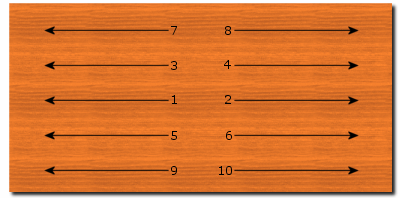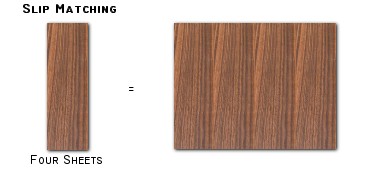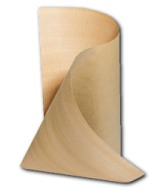 |
|
|
|
|
|
Part 1 |
Paper-backed veneer is real wood veneer permanently bonded to a paper backing. This backing is applied to keep intact the individual wood veneers used to make up the full width of the sheet. A four foot wide paper-backed veneer consists of multiple veneers glued together side by side. The backing also minimizes seasonal expansion and contraction of the wood caused by moisture content fluctuations due to changes in ambient humidity. The paper backing is generally available in a 10 and a 20 mil thickness. "Mil" or mil thickness is the common measurement of a coating. One mil equals 1/1000 of an inch. A quarter inch would be 250 mils. The backing is not removable. A 10 mil backing is fine for most projects. However, a 20 mil version is available for situations where the substrate is less than perfectly flat. In this case, the extra paper thickness allows the veneer to maintain a more consistent look after application. Keep in mind that 10 and 20 mil is a reference to the thickness of the paper backing, not the veneer face.
Wood-on-wood, also known as "2-ply veneer" is two wood veneers permanently bonded together. The face veneer grain is typically perpendicular to the backer veneer providing protection against bubbling that can occur when a veneer is improperly bonded to the substrate. This type of "crossband construction" allows the veneer to bend on moderate curves in the horizontal or vertical direction. The veneer used on the back side of a 2-ply veneer is often an imported species of lesser value. In most cases, 2-ply veneers are more expensive and a bit harder to work with than the paper-backed alternative. The veneer used on the back side of a 2-ply veneer is often a species of lesser value. Unless custom-ordered by a specialty manufacturer, the back side veneer is never the same species as the face veneer.
Pressure sensitive adhesive (PSA) veneer is a paper-backed veneer with adhesive film applied to the back of the sheet. It is a simple and easy alternative to applying veneer with a liquid adhesive. Utilizing 3M™ adhesives, PSA veneer provides a permanent bond to a smooth substrate that is dry and free of dust and contaminants. PSA-backed veneer is often a good choice for cabinet refacing, speaker building, and much more. It can be cut and trimmed with ordinary tools, such as scissors or a razor knife. Generally speaking, a project that uses a PSA paper-backed veneer can be considered slightly less durable than a paper-backed veneer that is applied with Titan DX contact cement. Keep in mind that PSA backed veneer is strong stuff and once it is applied, it cannot be repositioned. More information about applying a PSA veneer can be found further in this article. The PSA film used on a 4x8 veneer sheet is 48" wide. However, the veneer itself is typically over-sized an inch or so in width because the process of applying the PSA film is imperfect. It is a challenge to line up the PSA film with the exact edge of the veneer, so the factory over-sizes the veneer sheet by up to an inch. You simply have to trim those edges off before use, but you will end up with a 48" wide veneer. It is important to remember that the PSA layer has a shelf life of one year. Of course, that seems odd since it is not a liquid, but the manufacturer makes this claim and I have seen a couple of PSA failures where the cause may have been expired shelf life.
No. Each sheet is made up of several veneers called "components" which are placed side by side and typically with opposite sides showing - a process called bookmatching. The individual veneers used to make a sheet of backed veneer can range from 3" to 8" in width. With the exception of burls, the face veneers are 8 foot in length on a 4' x 8' sheet.
The veneers used to make a 4 x 8 sheet are typically laid up in the sequence from which they were sliced from the tree. This creates a visually pleasing result. If you look close enough you might be able to see the joint line because of the visual effect of the matching grain on the adjacent veneer on the sheet. The quality of the seam between each veneer is what defines the visibility of the joint. VeneerSupplies.com sells a higher grade of veneer in which joint issues simply do not occur. You will never see a gap or filler in the joint.
A typical paper-backed sheet is made from several sequential veneers. This creates a repetitive pattern across the full size sheet. Some users do not like the this look since it can make a panel look a bit fake. A plank matched paper-backed veneer solves this problem. It is made from individual veneers from different logs of the same species which creates a look of solid lumber more so that any other type of veneer lay up. This type of veneer can be difficult to find but they are available at VeneerSupplies.com in the "Paper-Backed Veneer" category.
VeneerSupplies.com is the companion website to the JoeWoodworker site, where you'll find thousands of veneer-related products including edgebanding and paper-backed veneer.
The resin infused backing that is used to make these sheets has an adhesive layer (between the veneer and the backing) that is applied at the factory level. This adhesive requires a high level of heat and pressure to activate which makes it unsuitable for do-it-yourself jobs. I've heard that some users adhere their veneers to thick kraft paper from the hardware store but I question the motivation for doing this and its effectiveness in keeping the veneer stable.
10 Mil Paper-Backed Veneer - .020" or 1/50" All thicknesses may vary by .005 inch. These dimensions are typical of the veneer and edgebanding offered at VeneerSupplies.com.
Generally speaking, the actual wood part of a paper-backed veneer is .015" but the thickness can vary based on the amount of finish sanding done at the factory. The factory sands each veneer sheet until it is perfectly smooth.
A 10 mil backed veneer is used when the substrate is smooth and flat. Some cabinetmakers will only use 10 mil veneer on vertical surfaces and 20 mil on horizontal parts such as desk and table tops but I 've never had any issues with 10 mil on a smooth horizontal surface even when I used a semi-gloss finish. Regardless of the substrate position, a 20 mil backed veneer veneer should be used if the substrate is not smooth since the thicker backer will help hide some substrate imperfections. There is a myth being passed around the internet that says 10 mil paper-backed veneer is not suitable for use with contact cement. In 20+ years of working with veneer, I have never found any problems with 10 mil paper-backed veneer adhered with a contact cement that is applied by roller. My gut feeling is that those responsible for perpetuating this myth are trying to needlessly upsell to a customer. There is no need to upgrade to 20 mil paper backing if a smooth uniform coat of contact cement is applied to a smooth substrate surface. Keep in mind that the wood veneer face is the same thickness regardless of the backer. The 10 or 20 mil specification refers only to the thickness of the paper backing.
The standard size for most backed veneer is 4' x 8'. The 4 foot measurement is the width of the sheet across the grain. The 8 foot measurement is the length of the sheet parallel to the grain. Most vendors oversize the sheets by ¼" on both the length and the width.
The part of the project that the veneer is applied to is called the substrate. Below is a list of common substrates and adhesives used in veneering. Keep in mind that the substrate must be smooth, clean, dry, and acclimatized prior to application of the veneer. Note that this chart applies to paper-backed veneers only. More information about various veneering adhesives can be found here.
2- Though it has been done, I do not often recommend application of paper-backed veneer directly to drywall. Instead, I recommend covering the drywall with ½" MDF using construction adhesive. The veneer can then be applied to the MDF. When this can not be done, application directly to drywall may be the only option. However, it should not be considered the most durable method. 3 - It is sometimes a good idea to coat porous substrates with shellac or oil-based polyurethane first and then sand it lightly when dry using 180 or 220 grit. Then apply the PSA veneer. The veneer should be permanently bonded to the project with a veneer scraper tool. These are simple and affordable tools used to "set" the bond. A roller will not work well for this, so get the scraper to avoid issues! 4 - Seasonal humidity changes can allow particle board can expand and contract more than some other substrates. This is only problem if there is concern about "creeping" of the veneer. This movement is most prevalent on flat cut wood veneers (particularly maple). To minimize creeping issues, use MDF instead of particle board and consider using a hard-setting adhesive. 5 - It is important to use a high grade of plywood. The face veneer on the plywood sheet must be bonded very securely to the core layer. Also, it is best to avoid using maple-faced plywood since it can be difficult to bond to this species.
Paper-backed veneer can be used with projects that will be exposed to weather, but it is often not very durable. Epoxy is the only adhesive and the only top coating that will withstand the outdoor environment and increase the durability of the veneer.
The veneer will be rolled tight inside the box. Be sure to handle the ends gently to avoid splitting when unboxing the veneer. Set it on a flat surface and lay at least one sheet of 3/4" plywood in top. It may be necessary to place weights on top to keep the veneer flat. Let it acclimate to your shop's environment this way for no less than 48 hours. It is critical that your shop humidity is approximately 40% RH. Higher or lower relative humidity will require much longer acclimation time. Paper-backed veneer stored and/or applied at very high or very low humidity will buckle. Without proper storage, application, or acclimation, the veneer will develop an irreversible buckle. It is recommended to keep the shop temperature between 70° and 80°F.
Contact Cement For solvent-based contact cement, it is a good idea to apply two coats (per side) with a glue roller. Water-based contact cement generally requires only one coat per side. If you are using contact cement, you'll only need a veneer scraper to apply the veneer. More information about the veneer scraper can be found on this page. A handheld roller is not suitable for applying veneer. It simply does not concentrate enough pressure over the contact surface to create a durable bond. A veneer scraper is a must! Be sure to scrape the entire veneer surface (scraping along the grain, never across it) to achieve a maximum strength bond. Most manufacturers recommend scraping the surface twice. Always use the centerline technique shown below when using the scraper tool.
PSA Veneer Keep in mind that PSA adhesives bond instantly on contact. Be certain that you have the veneer positioned correctly before applying the veneer. After the veneer has been scraped down, no additional clamping is necessary.
Cold Press Veneer Glue
No. If you are planning to use contact cement to bond your backed veneer to the project surface, then it is completely pointless to order a PSA veneer. Instead, just get a backed veneer without the PSA option and save the money. And if you are going to order a backed veneer with the PSA option, then don't apply contact cement to the project surface. Apply a coat of shellac or oil-based polyurethane if the surface is very porous and it will be fine. I've found no evidence that supports the idea that the PSA layer will not be corroded or oxidized by the solvents in contact cement. So, there is no point in getting a good bond now if it's going to fail later due to chemical incompatibilities between the contact cement and the PSA layer. There are people who claim to use both contact cement and PSA on a project because at some point they had a veneer with edges that lifted. I suspect that the vast majority of these failures were simply from the failure to use a veneer scraper tool. Don't underestimate the importance of this simple tool and technique.
The chemicals in a solvent-based contact cement can cause an existing coating on the substrate to turn to muck which can greatly affect the bond strength. If you opt to use a water-based contact cement instead, you will find that it requires a porous substrate surface. Since a top coating on the substrate would greatly reduce porosity, it must be removed before the adhesive is applied. A paper-backed veneer can still be put over a painted or lacquered surface. Instead of a liquid adhesive, consider using a PSA (pressure sensitive adhesive) instead. All of the paper-backed veneers on the VeneerSupplies.com website have this option. Just make sure the surface coating is firmly bonded to the substrate. Otherwise, the veneer will hold no better than the coating under it.
If you are using contact cement or PSA to bond the veneer to the substrate, it is likely that the joint will either open up or bind-and-rupture. Use a hard setting adhesive such as Ultra-Cat or Better Bond X-Press veneer glue instead. These adhesives will require a means of clamping the entire veneer surface while the glue sets up. A vacuum press is the ideal means of doing this.
After the veneer has been stained and finished, the backer is barely visible on most species. Below is a picture of my desktop with a paper-backed cherry veneer used on top and a cherry hardwood edge. The line between the backing and the face veneer is almost impossible to see.
Generally speaking it is not ideal to pre-stain a veneer for two reasons.
Advantages
Disadvantages
Slip matching (where all veneer faces are in the same direction) is often used in quartersawn and rift cut veneer to minimize the barber pole effect.
Sequence matching is the process in which the factory ships the customer sheets of veneer that reasonably match each other in terms of color and grain pattern. This option is great for large projects where consistency is critical to success. Some suppliers offer a "reasonable match" option for a small fee in which they will select two sheets of veneer that reasonably match each other in grain and color.
The veneer is sanded to approximately 150 grit at the factory.
Paper-backed veneer can be cut to size with scissors or a razor knife. Trimming a veneered panel is most commonly accomplished with a flush-trimming ball bearing piloted router bit. You can also trim the veneered panel on a table saw with an 80-tooth saw blade.
It is rolled up and shipped in a 6" x 6" x 50" cardboard box. At VeneerSupplies.com, the box tends to be closer to 9" x 9" x 50" and is double-walled so that the chances for shipping damage are greatly reduced.
If you choose to apply a paper-backed veneer over bendable plywood, we recommend first adhering 1/8" MDF to the plywood with a hard-setting glue such as a PPR to add strength and rigidity.
Since it is a real wood product, paper-backed veneer takes a stain just like a piece of solid lumber. However, many users find that they get a more even stain color if they sand the veneer one grit grade higher than the rest the project. So if you sanded the solid wood parts of a project with 150 grit sandpaper, you might consider sanding the veneered parts with 180 grit to get optimum color matching. It is best to apply a protective finish to the veneer when the ambient humidity is 55% or less. Do not use heavy coats of finish. Instead build up multiple smaller coats which dry faster and trap less solvent under the finish. Additionally most catalyzed finishes will "check" or crack if applied too thick. Water-based stains and top coats are not considered ideal choices paper-backed veneer, but they will work as long as the veneer is properly bonded to the substrate. If you must use this type of finish, it helps to apply a vinyl or acrylic sanding sealer to the veneered panel before staining and finishing.
Since there are many combinations of veneer, substrates, adhesives, finishes, and environmental conditions, we highly recommend testing a small piece of veneer with your application and finishing process before you begin the main veneer work. Be certain to check for bubbles before applying your finish. If bubbles are present, this may be the only time to address these issues. The best way to check for bubbles is to place a powerful light (such as a halogen work lamp) beside the veneered panel and no more than 15 degrees above it. Look for peaks and shadows across the panel. Most bubbles can be easily repaired. PSA and Contact Cement: Place a piece of cotton or flannel cloth over the bubble and gently heat the bubble with a clothes iron. The heat will often reactivate most contact cements. Keep the iron in motion to prevent overheating the veneer. Once the veneer is adequately heated, scrape the bubble again (in the direction of the grain) until the area cools down. Heat Lock: Within 24 hours of application Heat Lock can be reactivated. Place a piece of cotton or flannel cloth over the bubble and gently heat the bubble with a clothes iron. Keep the iron in motion to prevent overheating the veneer. Once the veneer is adequately heated, scrape the bubble with a veneer scraper or block of softwood until the area cools down. Cold Press Veneer Glue: When high quality cold press veneer glue is used with a vacuum press, bubbles are generally not a problem. In the event that a bubble does show, the ironing method described above can sometimes fix the issue.
I always use a paper backed veneer on the back side of my panels if the face side uses a paper backed veneer. Others say they never use a backer/balance veneer and haven't had any warping problems. I think this largely depends on several factors.
The best option may be to use a water-based contact cement and back the panel with a cheap paper-backed veneer. This is what I do and I never have to worry about warping. |
|
|
|








 Iron-On Veneering with Heat Lock™ Glue
Iron-On Veneering with Heat Lock™ Glue
 When veneer is sliced, a distortion of the grain occurs. The knife blade, as it hits the wood, creates a "loose" side where the cells have been opened up by the blade and a "tight" side. Because the tight and loose faces alternate in adjacent pieces of veneer in book matching, they may accept stain differently. This may result in a noticeable color variation called "barber poling".
When veneer is sliced, a distortion of the grain occurs. The knife blade, as it hits the wood, creates a "loose" side where the cells have been opened up by the blade and a "tight" side. Because the tight and loose faces alternate in adjacent pieces of veneer in book matching, they may accept stain differently. This may result in a noticeable color variation called "barber poling". 


 Most paper-backed veneer species can take up to a 1" radius bend along the length of the grain and 5" radius bend across the grain. A light coat of
Most paper-backed veneer species can take up to a 1" radius bend along the length of the grain and 5" radius bend across the grain. A light coat of